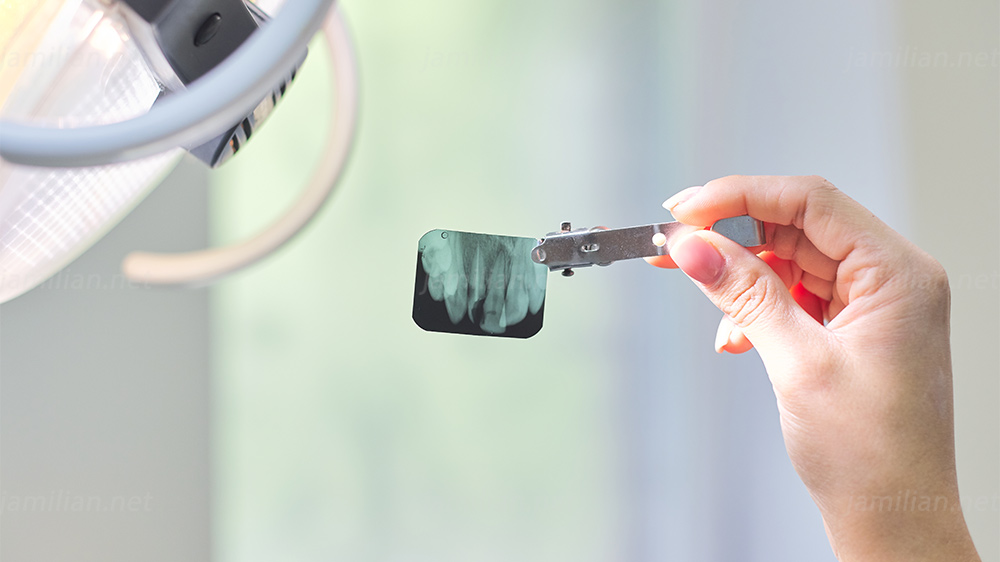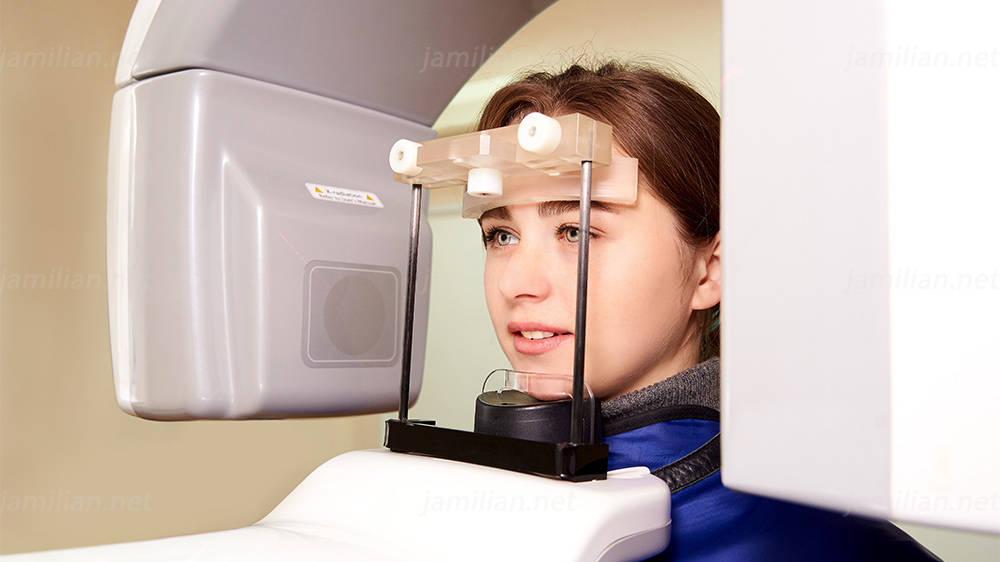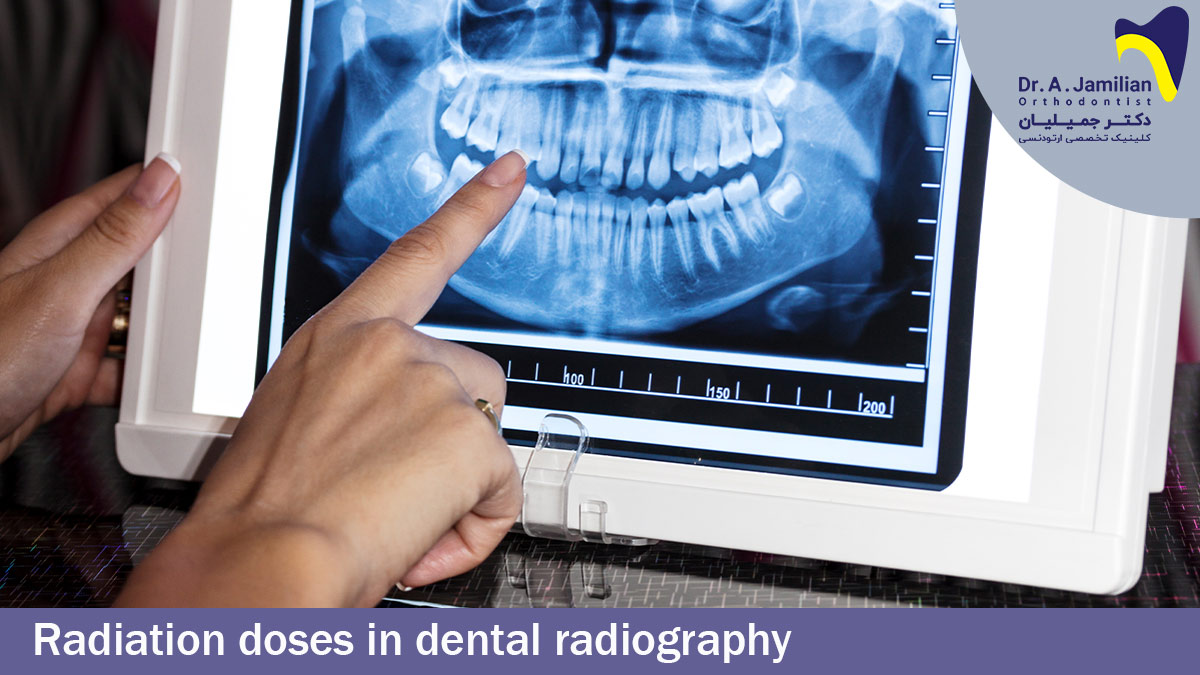For dentists, diagnosing the pain and disorders’ cause is very important. Radiology images are used to determine tooth decay severity Many patients who visit a dentistry clinic may be afraid of x-ray radiations and their potential risks for their bodies; to these patients it must be said that the dose used in the dentistry radiographies is very low.
The total dose of four normal bitewing radiographs (or periapical) is about 0.005 millisievert (mSv), which in fact is equal to cosmic rays you may normally receive in a normal day. You would experience the same dose of harmful radiation that you would receive when you fly only for two hours. Panoramic radiography needs x-ray radiation two times more than this dose (i.e. two-day normal cosmic radiation).

Periapical radiograph
Dental Radiography and its Applications
Radiography is a method in which x-ray radiation is used to take any amount of images of patients’ teeth and jaws. We use this to make easy diagnosis of any problem and abnormality for patients. After imaging with this technique, editing the images’ contrast and details would help to better diagnose the underlying problem. In this technique, it is possible either to develop the images over special film screens or to copy them to CDs or electronic files.
Dental radiography has many applications in dentistry, some of which are explained briefly here:
- Diagnosing tooth decay
- Restoring teeth
- Showing the filled teeth
- Showing the empty spaces between tooth
- Showing bone infections
- Finding gum diseases and infections
- Showing dental abscess
- Showing dental costs, etc.
X-Ray Risks
A famous knowing is that t x-ray is harmful for our body and it may cause various sorts of cancers. Hence, many people who decide to take images of their teeth may be worried about such risks. Before anything else, it must be clear that you, as a patient, may not need to take images of your teeth even once a year. However, if you need dental radiography, you need to know that the radiation dose is so low that it doesn’t have any risk and harm to your body.

Radiography
Maximum Permissible X-Ray Dose
The maximum permissible dose of x-ray people can take without any concern about its subsequent risks has been measured by experts. It’s a cumulative dose: the total dose of radiation irradiated to someone’s body within a full year, which must be less than a certain level.
The irradiated x-ray dose is measured with millisievert (mSv). Typically, people receive 3 mSv/year of radiation from their local environment, also known as Cosmic Microwave Background Radiation (CMBR). The permissible received ionizing radiation for anyone within a year (except the CMBR and emergency cases) is 1 mSv. The received radiation dose through radiography and other imaging techniques is different and varies from 5 mSv through abdominal CT-Scan to 0.001 mSv through organ radiography. The irradiated radiation doses through various dental imaging techniques are as follows:
- 1 Intraoral dental radiography: 0.008 mSv
- OPG: 0.01 mSv
- CBCT with ideal machine: 0.04 to 0.08 mSv, depending to the irradiated section size
As you see, the radiation dose people may receive during dental radiographies is very lower than the annual permissible level. Therefore, there is no serious concern about the irradiated radiation during dental radiography. However, we should try our best to minimize the irradiated dose on people, because it has been demonstrated that even the lowest doses may cause negative consequences for people. For this reason, the necessary protocols are always met in the imaging centers. Before starting to work, a protective apron is put on different parts of the body including ribs, abdomen and pelvis in order to avoid any unwanted radiation to the vital organs of the body. Moreover, for taking dental images of more vulnerable people like children and pregnant women, we need to use a thyroid shield too.
Comparing Radiographic Ray with other Rays
This dose of dental radiography is not comparable with the dose used in medical radiographies (an example of a medical radiographies is CT-scan Gamma rays). Dental radiography is also very low in contrast to them. Thus, patients shouldn’t need to be worried about the irradiated rays during radiography, because the dose used here is very tiny and ignorable.
FAQ about Dose of Dental Radiography
1- Is there any ban on using dental radiography for pregnant women?
An exact answer to this question depends on several factors including the fetus age, the dentist’s diagnosis and patient’s condition. However, because of the potential harm of such rays for the fetus, the radiography must be avoided for the pregnant women as much as possible. In cases when radiography is necessary for a pregnant woman, dental radiography is suggested in the third trimester of pregnancy when the fetus organs are formed and the most dangerous time for radiography is the first trimester.
2- Is it necessary to use shields against rays during dental radiography?
Although often no shield is used for patients who has not any special medical condition and also not for those who may need radiography only once in a year, lead aprons and thyroid collars are used for patients with underlying diseases such as thyroid diseases, children and pregnant women in order to minimize x-rays radiation absorption and its consequences.
3- Does dental x-ray have side effects?
Since it is exposed to radiation, there are always potential side effects. However, if the safety instructions are met properly, the absorbed radiation is so little that its side effects can be ignored.






